Sunday Apr 20, 2025
Sunday Apr 20, 2025
Tuesday, 19 March 2024 00:00 - - {{hitsCtrl.values.hits}}
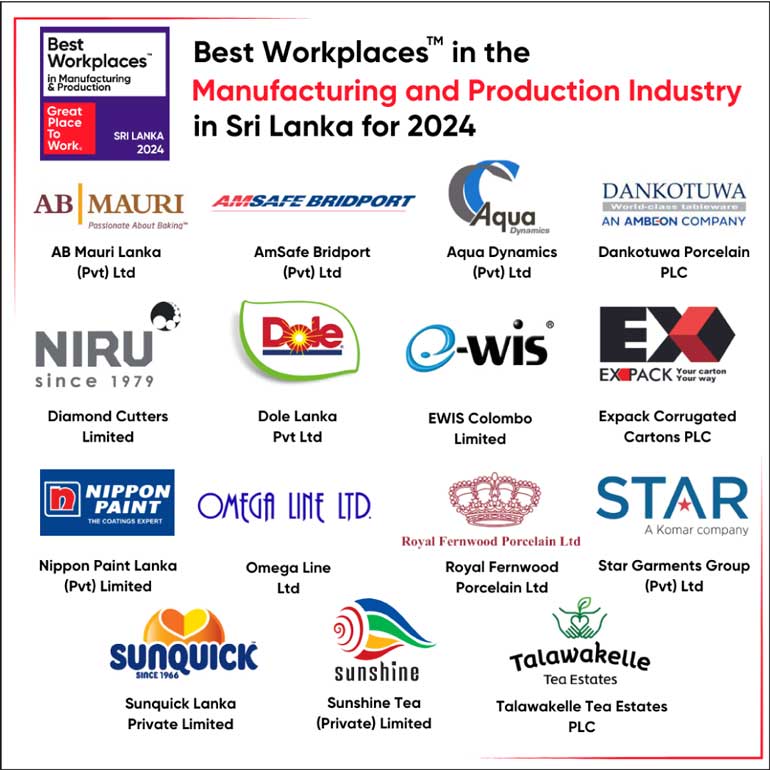
By Great Place to Work® in Sri Lanka
Fabricating Futures: Harnessing People Power for Productivity and Innovation
Fostering a strong Manufacturing and Production (M&P) sector is crucial for addressing Sri Lanka’s current economic challenges and therefore it is a key sector studied by Great Place to Work® in Sri Lanka. It contributes an estimated 16.3% to the national GDP in 2023 albeit a 2.1% reduction over the previous year (CBSL, 2023). The decline can be attributed to various economic woes, including inflation of costs, global supply chain disruption, import restrictions, decrease in export demand, tax revisions, skilled labor shortages and limited external financing leading to hampered production capacity, reduced competitiveness, and workforce discontent.
Despite these challenges, the industry emphasized quality, maintaining standards, and showed signs of recovery with an overall upward trend in the country’s Manufacturing Purchasing Managers’ Index (PMI) ending above 50 in December. Government activity to stabilize the economy provides cautious optimism for 2024.
A crucial focus for overcoming challenges is the improvement of productivity in the sector. Workforce engagement and retention of the best talent are key to doing so and healthy workplace culture is paramount to sustain. Gauging employee sentiment, identifying areas to improve and taking continuous action are strategic imperatives in doing so. This Study sheds light on current employee feedback from the sector and is an opportunity for all organizations to learn from and act so that Sri Lanka can unlock potential for a brighter future.
Study Summary
During this year’s study cycle, nearly 33,700 employees across 40 organizations from the industry were surveyed with an average response rate of 90%. This study data helped to determine the 15 Best WorkplacesTM in the Manufacturing and Production industry and understand the differentiating factors between the best vs the rest. Organizations that were Great Place to Work Certified™ from March 2023 to February 2024 were considered for this study.
Methodology for Selecting the Best Workplaces
Great Place to Work is the globally recognized authority on studying and identifying Best Workplaces. Over the past 30+ years it has studied Great Workplaces and expanded its reach to over 150 countries and territories. Organizations utilize services to benchmark, understand key strengths and areas to improve on and act to drive workplace culture that supports organizational performance. The Sri Lankan study is based on the global model and a rigorous methodology, which has been researched, tested, and carried out in similar studies worldwide.
The selection follows the global ‘Great Place to Work For All’ methodology. 85% of the evaluation is based on the experience of trust and employees reaching their full human potential as part of their organizations – no matter who they are or what they do. These experiences are analyzed in relation to each company’s size, workforce demographics and industry norms. The remaining 15% of the evaluation is based on all employees’ daily experiences of innovation, their organizations’ values, and the effectiveness of their leaders to ensure a consistent positive experience.
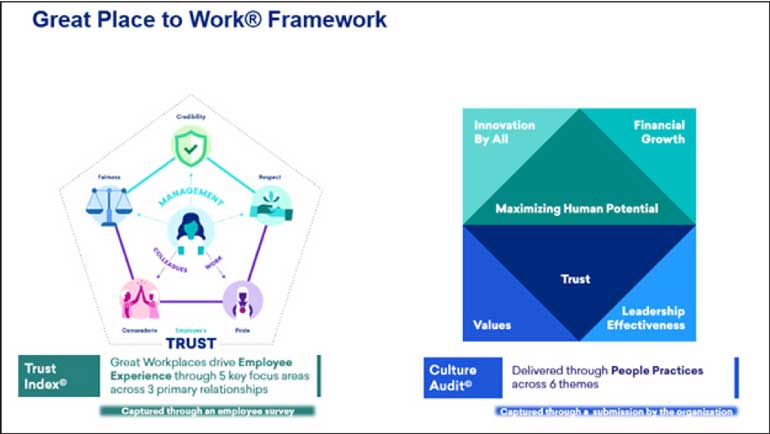
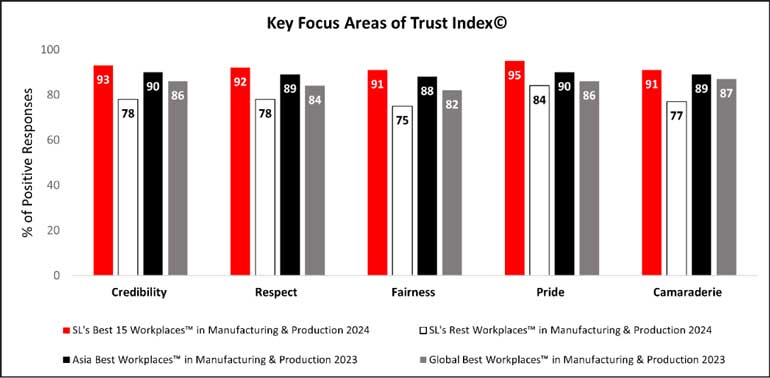
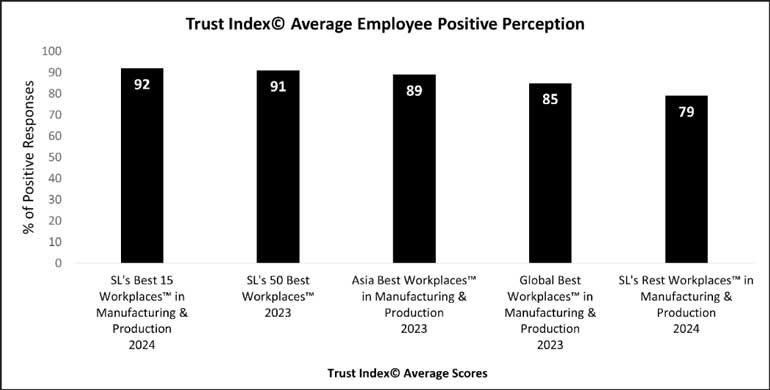
The measurement tool used to assess workplace culture is based on two lenses; Firstly, the Trust Index© employee perception survey is conducted to understand the employee workplace experience and constitutes 75% of the total organization score. In Sri Lanka, only organizations certified (Certification is valid only for a period of 1 year) as a great workplace with more than a 70% minimum positive employee perception are considered for Best Workplaces studies in that year. Organizations are measured on whether employees Trust the people they work for, have Pride in work they do and share Camaraderie among people they work with. Secondly, the practices and processes in place to drive the employee experience are evaluated through a central submission termed the Culture Audit which constitutes the remainder 25% of the total score. Results for listed organizations are audited to maintain accuracy and validity of their inclusion in the Best Workplaces List.
Results Overview
Figure 1 compares the Trust Index (TI), which is a measure of the average positive perception of employees. The TI was measured across 58 core global statements and provides an ‘analytical viewpoint’ of an employee.
Figure 1: Trust Index© Average Employee Perception
While the global Trust Index (TI) remained stagnant over the last year, a positive shift brewed within Asia’s landscape with the region’s top-performing workplaces seeing a 2-point increase in average TI. It’s noteworthy that Sri Lanka’s Best not only scored higher than Asia’s Best but also improved by a single point compared to last year. However, the Rest of the organizations maintained their score, albeit widening the gap with their high-performing peers in the country.
Key Focus Areas
Figure 2 displays the 5 key focus areas measured by the Trust Index employee perception survey. Sri Lanka’s M&P industry excels in the key focus area of pride.
Figure 2: Key Focus Areas Trust Index© Employee Survey
Relatively, focus areas camaraderie and fairness are perceived lower. Diving deeper shows that the aspects of hospitality and cooperation among employees for camaraderie and equity and impartiality for fairness drag perception down in these areas. Fairness has continued to be a low perceived area over the years, but camaraderie being scored relatively lower by employees could stem from the economic crisis and challenges employees’ encounter. Workplaces facing financial strain may struggle to prioritize hiring experience and fostering cooperation.
Health Indices for Organizational Culture
Figure 3 highlights the key indices of a healthy organizational culture and being a ‘Great Workplace For All’. While the organizational culture health score of the global Best has remained unchanged for the past two years, Asia’s M&P industry shows signs of progress. This encouraging trend extends to Sri Lanka, where the Best 15 outperform Asian counterparts, marking them as leaders in Asia. The employees within these organizations express a strong sense of purpose and belonging, reflected in statements like, “ People look forward to coming to work here” and “I want to work here for a long time!”
Figure 3: Organizational Culture health indices in the Trust Index© employee survey
The biggest gap of 13 percentage points in the level of daily motivation between the Best 15 vs the Rest is noteworthy showing that despite the trying conditions in the country the Best are contriving to do better. Delving deeper shows that key contributors to daily motivation among employees of the best have been access to facilities that contribute to work and seeing pride in accomplishments.
The Rest in the study registered a decline in employee retention (1 point) highlighting potential stress within the industry, possibly due to the talent crunch the nation faced last year. The highest correlations for retention among the Best were pride and egalitarian treatment.
Unlocking human potential: Innovation by All
Figure 4 lists areas that are the roots of an innovation by all culture that reflect engagement and increase an organization’s propensity to innovate over time.
Figure 4: Roots of Innovation measured in the Trust Index© employee survey
For indicators such as agility and recognition of effort, the Best either surpasses or is on par with global and Asian Best, while the Rest has significant gaps to close, the biggest being the recognition given to effort for continuous improvement at 15 percentage points.
“Innovation by all” is a transformative force. It signifies a collective commitment to creativity, problem-solving, and continuous improvement. When every worker contributes ideas, embraces novel approaches, and collaborates across hierarchies, the entire industry thrives. By fostering a culture that encourages diverse perspectives, rewards experimentation, and values learning, organizations empower their workforce to drive progress.
Key Drivers of the Workplace among the Best
Key Drivers are the areas from the Trust Index employee survey that strongly correlate to employees perceiving their workplaces as great and contributing to high performance culture. These areas influence the long-term bond between employees and the organization. The top drivers for employees of the Best are strong manager role modeling and egalitarian treatment in their organizations. These behaviours in the leadership help create a fair and trusting environment.
Where the Best 15 outperform the Rest
Figure 5 depicts the biggest gaps between the Best vs the Rest. The Best seems to have understood that genuine and sincere leadership, whose actions match their words, fair treatment of employees, and a culture of empowerment are the hallmarks of organizational success.
Figure 5: Key Differentiators between the Best 15 vs. the Rest
A staggering 18% or higher gap separates the two groups, with 91% of employees in the Best workplaces feeling their management walks the talk, compared to just 73% in the Rest. A great deal of this difference can be attributed to implementing effective people practices and grooming positive values and behaviour in people managers that drive a more consistent experience for employees. It’s noteworthy that elements of fairness are key differentiators between Best vs the Rest.
Pursuing excellence – Strengths and Opportunities to Improve
The study shows that once again the top two strengths for Best in M&P are Pride in Organization (B 96%, R 85%) and Good facilities (B 96%, R 84%). Additionally, this year employees have shown confidence in management competence (B 96%, R 83%) at running the business and showing clarity of vision during unpredictable times.
The ‘Best’ Sri Lankan M&P organizations excel, yet growth opportunities persist. Figure 6 highlights areas that can still improve in both Best and the Rest. The top three areas identified continue to be areas to enhance from the last study as well.
Figure 6: Areas for improvement among the Best 15 in M&P
Open communication and fair performance systems, adjusted for the current economic reality, are vital for ensuring equitable promotions. Managers play a crucial role in maintaining a healthy organizational culture, and efforts must persist to keep workplace politics and favouritism in check. Granting employees freedom to make honest mistakes without fear of reprisal enhances empowerment and ability to develop.
The challenges of the economic crisis may have pushed organizations away from meeting some of these fundamental needs. This can include the pressure to maintain efficiency amidst limited resources and therefore managers micromanaging with less tolerance for mistakes. Prioritizing individual well-being and a shared sense of purpose can solidify the Best’s position as leaders in an engaged workforce. While efficiency prevails during intense periods, camaraderie and fun which are essential for employee well-being and retention – may suffer. To address this, genuine connections and team spirit should be encouraged, along with celebrating individuality.
Conclusion:
Sri Lanka’s manufacturing and production industry stands at a crossroads, buffeted by global economic turbulence, rising geopolitical tensions, and talent shortages. These conditions are unlikely to ease. For example, Korn Ferry’s Global Talent Crunch study projects the manufacturing industry to face a talent deficit of 7.9 million workers by 2030. To overcome these challenges, innovation and improved productivity are essential, requiring adaptable workplaces to enable employees to reach their full potential.
The Best organizations in the industry pave the way by creating workplaces that promote trust, engagement, and service excellence. However, creating a truly thriving workplace involves adaptability and a continuous journey of improvement.
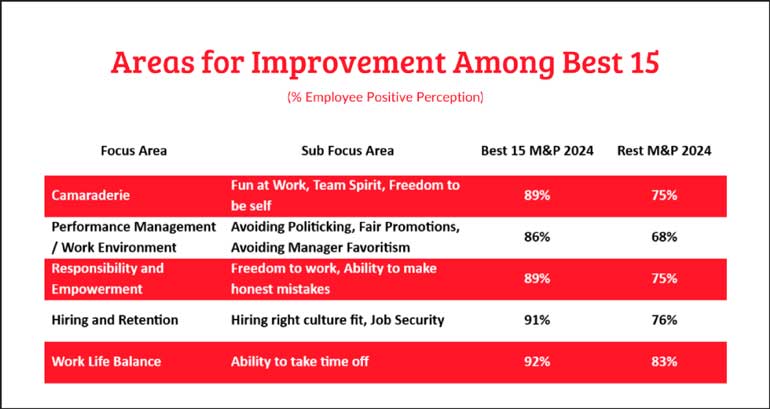


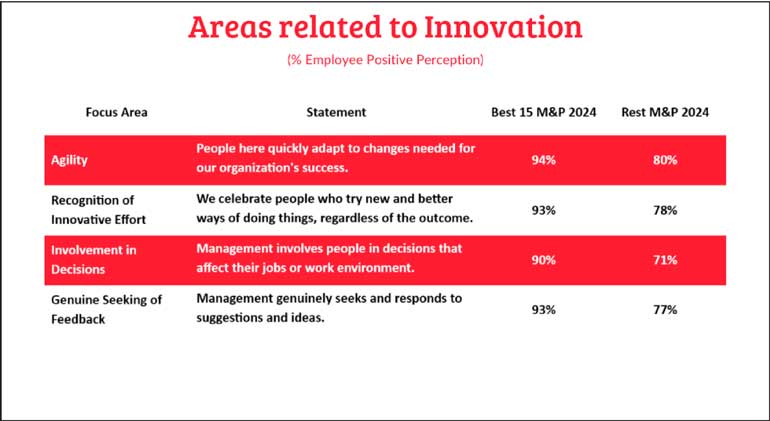
Great workplaces are an investment in the future. By focusing on the key points identified in this study, and nurturing the “Best” practices to sustain consistent employee experience Sri Lanka’s M&P industry can attract talent, drive innovation thereby increasing productivity and competitiveness to create a brighter future for the entire industry and the nation.
Great Place to Work®’s mission is to help every workplace become a Great Place to Work For AllTM so that organizations can maximize human potential through a High-Trust, High-Performance CultureTM that drives business, improves lives, and creates a better society. No matter where you are in your journey, you are invited to join in to discover and drive your employees’ positive perception and contribute to achieving the vision of making Sri Lanka a great place to work.
Please contact Great Place to Work© in Sri Lanka at 074 330 2269 / +94 11 454 5594 or visit www.greatplacetowork.lk for more information.
Discover Kapruka, the leading online shopping platform in Sri Lanka, where you can conveniently send Gifts and Flowers to your loved ones for any event including Valentine ’s Day. Explore a wide range of popular Shopping Categories on Kapruka, including Toys, Groceries, Electronics, Birthday Cakes, Fruits, Chocolates, Flower Bouquets, Clothing, Watches, Lingerie, Gift Sets and Jewellery. Also if you’re interested in selling with Kapruka, Partner Central by Kapruka is the best solution to start with. Moreover, through Kapruka Global Shop, you can also enjoy the convenience of purchasing products from renowned platforms like Amazon and eBay and have them delivered to Sri Lanka.
Discover Kapruka, the leading online shopping platform in Sri Lanka, where you can conveniently send Gifts and Flowers to your loved ones for any event including Valentine ’s Day. Explore a wide range of popular Shopping Categories on Kapruka, including Toys, Groceries, Electronics, Birthday Cakes, Fruits, Chocolates, Flower Bouquets, Clothing, Watches, Lingerie, Gift Sets and Jewellery. Also if you’re interested in selling with Kapruka, Partner Central by Kapruka is the best solution to start with. Moreover, through Kapruka Global Shop, you can also enjoy the convenience of purchasing products from renowned platforms like Amazon and eBay and have them delivered to Sri Lanka.